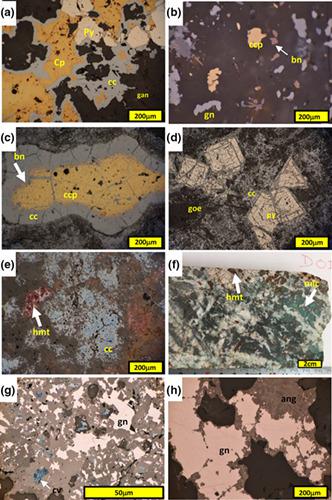博茨瓦纳东北部Matsitama片岩带Mowana铜矿的地质、矿物学和硫同位素
IF 0.8
4区 地球科学
Q3 GEOLOGY
引用次数: 1
摘要
Mowana热液铜矿位于博茨瓦纳东北部津巴布韦克拉通西南部的Matsitama-Motloutse杂岩内。通过地质、石英结构、矿石矿物学、绿泥石地温、硫同位素等分析,记录了该区成矿特征。矿床赋存于新太古代至古元古代Matsitama沉积群碳质和泥质变质沉积岩的石墨片岩透镜体中,为北北东向、近垂直倾斜(70-80°)的Bushman线条。热液蚀变主要表现为硅化、绿泥石化、绿帘石化、绢云母化、赤铁矿化和方解石蚀变。根据蚀变矿物组合,主要成矿阶段为~200 ~ ~340℃温度下pH值接近中性的流体。莫瓦纳矿床的贱金属成矿演化出至少两种脉型。第一种矿化类型以石英+方解石±钾长石脉和角砾岩为代表,以黄铜矿为主,黄铁矿、少量斑铜矿和微量方铅矿为主。2型矿脉为石英+方解石±萤石矿脉,含方铅矿。表生成矿作用广泛分布于矿床浅层,主要表现为辉铜矿、斑铜矿、银榴石、角闪石、孔雀石和赤铁矿的显著存在。1型脉中绿泥石的地热测量温度表明,与绿泥石蚀变有关的矿化形成于340 ~ 400℃。矿石矿物组合为黄铁矿、斑铜矿和黄铜矿,配以绿泥石地热资料,表明1型矿脉形成于中至高硫化状态。硫化物的硫同位素比值表明,岩浆S和(或)寄主变质沉积岩的浸出作用和海水硫酸盐的封闭系统还原作用是硫的来源。本文章由计算机程序翻译,如有差异,请以英文原文为准。

Geology, mineralogy, and sulfur isotopes of the Mowana copper deposit, Matsitama Schist Belt, NE Botswana
The Mowana hydrothermal Cu deposit is located within the Matsitama–Motloutse Complex in the southwestern part of the Zimbabwe Craton in the northeastern part of Botswana. This study aims to document the characteristics of the mineralization based on geology, quartz textures, ore mineralogy, chlorite geothermometry, and sulfur isotope analyses. The deposit is hosted by the NNE‐striking and nearly vertically dipping (70–80°) Bushman Lineament, within the graphitic schist lenses in the carbonaceous and argillaceous metasedimentary rocks of the Neoarchean to Paleoproterozoic Matsitama Sedimentary Group. The hydrothermal alteration of the host rocks is characterized by silicification, chloritization, epidotization, sericitization, hematite, and calcite alteration. Based on the alteration mineral assemblage, the main mineralization stage is attributed to near neutral pH fluids at temperatures between ~200 and ~340°C. The base metal mineralization of the Mowana deposit was evolved in at least two vein types. The first mineralization type, represented by the quartz+calcite±K‐feldspar veins and breccias is characterized by the precipitation of principal chalcopyrite with pyrite, minor bornite, and trace amounts of galena. The Type 2 veins represented by the quartz+calcite±fluorite veins, host appreciable amounts of galena. The supergene mineralization widely distributed in the shallow levels of the deposit is manifested by the significant presence of chalcocite, bornite, covellite, anglesite, malachite, and hematite. The temperature obtained from the chlorite geothermometry in the Type 1 veins indicate that the mineralization associated with chlorite alteration formed at a temperature ranging from 340 to 400°C. The ore mineral assemblage: pyrite, bornite, and chalcopyrite, paired with the chlorite geothermometry data indicate that the Type 1 veins formed at an intemediate to high sulfidation state. Sulfur isotopic ratios determined on the sulfides indicate the magmatic S and/or leaching of the host metasedimentary rocks and closed system reduction of seawater sulfate as the sources of S.
求助全文
通过发布文献求助,成功后即可免费获取论文全文。
去求助
来源期刊

Resource Geology
地学-地质学
CiteScore
2.30
自引率
14.30%
发文量
18
审稿时长
12 months
期刊介绍:
Resource Geology is an international journal focusing on economic geology, geochemistry and environmental geology. Its purpose is to contribute to the promotion of earth sciences related to metallic and non-metallic mineral deposits mainly in Asia, Oceania and the Circum-Pacific region, although other parts of the world are also considered.
Launched in 1998 by the Society for Resource Geology, the journal is published quarterly in English, making it more accessible to the international geological community. The journal publishes high quality papers of interest to those engaged in research and exploration of mineral deposits.
 求助内容:
求助内容: 应助结果提醒方式:
应助结果提醒方式:


